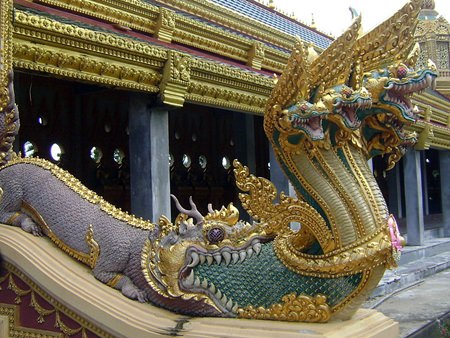Now I don’t know about you, but I am not terribly keen on snakes. We found one sleeping in the bathroom the other day with a large bulge in its middle, so it must have swallowed a toad or something. A couple of hours later, the snake had disappeared, much to everyone’s relief. Yesterday, I was reading the interesting fact that there are evidently no snakes in Bermuda or Iceland. They don’t have snakes in Antarctica because it’s too cold, although the penguins don’t seem to think so. There are none in Ireland either, because they were very sensibly banished a long time ago by Saint Patrick. Oddly enough, there are no land snakes in New Zealand but the country is evidently visited on rare occasions by a thing called the yellow-bellied sea snake. Snakes live on the ground, in trees, and in water. Of course, the most well-known water-snake in these parts is the Naga. You’ll know about the Naga, because everyone in Thailand knows about the Naga. In case you’re new around here, it’s the Sanskrit and Pali name for a gigantic hooded cobra and known throughout Indian and southeastern Asian cultures. It’s often believed to be a real animal with a supernatural spirit, and many people in the region honestly believe that the animal lives in the local waters. Actually, so do I. The Phaya Naga is that serpent-like creature that lives in the Mekong River and spits out fireballs around this time of year.
 A multi-headed Naga emerges from the mouth of a Makara at Phra Maha Chedi Chai Mongkol, Roi Et (Photo: Pawyilee).
A multi-headed Naga emerges from the mouth of a Makara at Phra Maha Chedi Chai Mongkol, Roi Et (Photo: Pawyilee).
I only mention snakes because Naga is the trade-name for some basic wines from Siam Winery. As you probably know, the company produces a wide range of blended wines including Monsoon Valley, Mont Clair, Mar Y Sol, Peter Vella and Berri Estates. I’m sure you’ve come across them before. You could safely offer either of these Naga wines to guests who are wine beginners. Now I am not using this word disparagingly, because we’ve all got to begin somewhere. People who are new to wine tend not to like acidic flavours or strong tannins. The Head Winemaker at Siam Winery is Kathrin Puff and she has crafted these two excellent but undemanding easy-drinkers to complement Thai cuisine. Talking of which, Thai cuisine can present a bit of a problem to match with wine because of the wide variety of flavours and textures. Many food writers recommend a German Riesling, because an off-dry wine with a dash of acidity would go well with spicy food. Another wine recommended for Thai food is Grüner Veltliner, which I am afraid is a somewhat impractical suggestion because this Austrian wine is rarely seen in these parts. And of course, a decent Riesling isn’t all that easy to find either. These Naga wines are available in many restaurants and hotels.
Naga Siam White Blend 2013 (Thailand) (Various outlets)
This is a pleasant, light yellow wine with an attractive fruity aroma. You might pick up the smell of green apples, citrus and a faint touch of grapefruit. There’s also a hint of melons. Predictably, the wine is very soft on the palate, absolutely loads of fruit and only the slightest touch of acidity. Acidic whites really tend to put beginners off, and to my mind very acidic wines simply don’t work with many Thai dishes, whereas just a light touch of acidity does the trick.
It’s blended from Chenin Blanc and Colombard, both of which originally came from France but are now grown successfully in Thailand. Chenin Blanc is often considered an excellent partner for Thai food and easier to find than a Riesling. The wine is dry, but it’s not as dry as the proverbial bone. “Off-dry” is perhaps the best expression. A dash of slight sweetness in the wine can provide a pleasing balance for hot and spicy Thai dishes. Ray Isle, the poetically-named wine editor of the Food & Wine magazine, also claims that off-dry wines with a touch of acidity make good partners for Thai food. This one would go a treat with many Thai dishes and I am sure many non-wine drinkers would find it attractive. I tried it out with a plate of spicy fried rice, egg and vegetables. It worked well. Strangely enough, the food made the wine taste a little bit drier.
Naga Siam Red Blend 2012 (Thailand) (Various outlets)
This wine is described as being “blended from several well-known grape varietals such as Shiraz” but what the well-known grapes actually are is probably anyone’s guess. I was interested to compare this wine with Mont Clair Bin 5, which you may recall is a blended Cabernet Sauvignon from the same company. Incidentally, although the word “bin” originally meant a part of the cellar reserved for particular wines, it’s now only used as part of a trade name. Many Australian wineries like to brand their wines as “Bin 65” or some such thing. This light-bodied Naga has a rather sweet aroma of red currants, plums, touches of herb and a slightly peppery quality that presumably comes from the Shiraz in the blend. Compared to the Mont Clair, the wine has a softer, gentler mouth-feel but it’s not quite as dry. There’s plenty of fruit and a lively tang on the taste which will help to soften the powerful flavours of spice in Thai curries.
Not surprisingly, there’s virtually no tannin on the palate so the wine could well appeal to wine beginners who are reluctant to try reds. In any case, the flavours of Thai food can be difficult to match with tannic wines, because the food can sometimes make the wine taste bitter. Big oaky reds don’t usually work with Thai dishes either. There are bound to be exceptions, but if you want to play it safe stick with off-dry whites or very light reds. For wine beginners, try these two Naga wines. A snake in the glass, you might say. Or perhaps you might not. But at the tail end of the week, it’s the best I can manage.




